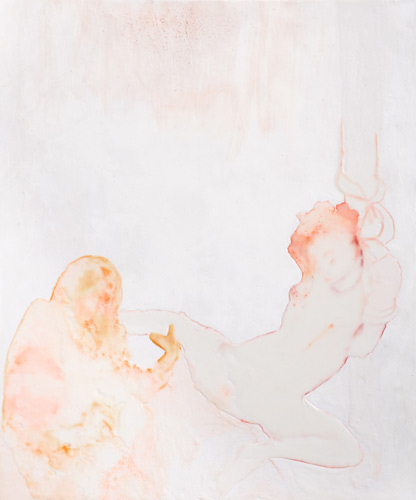Penny Siopis’s new show combines video installation and glue-and-ink paintings to harrowing effect, inviting us to bear witness to history through potentially misleading representations
I am a man without a country,” Demitrios Tsafendas tells his interrogator in a scene somewhere beyond the montage of holiday video footage in Penny Siopis’s video installation, Obscure White Messenger.
A rare sortie for an artist renowned for her painting, Obscure White Messenger is a central work in Siopis’s solo exhibition, Furies, which shows at Brodie/Stevenson until September 18. The piece recounts statements and snippets of dialogue between Tsafendas and counsellors or interrogators shortly after he stabbed Hendrik Verwoerd to death in 1966.
Against a backdrop of footage of foreign countries and domestic customs a strip of white text tells us that Tsafendas was denied citizenship in the three countries to which he had any attachment — Mozambique, Egypt and South Africa. It also tells of how his application for “coloured” status in South Africa was denied and as a result he couldn’t marry “the one girl who wanted to marry [him]”.

Penny Siopis, Hungry Ghost, 2010, ink and glue on canvas, 61cm x 51cm series
Although Verwoerd’s assassination was believed by many to be a madman’s blunder, Siopis’s selection of dialogue is sympathetic. It shows Tsafendas to be thoroughly displaced and vulnerable, a victim of political perversities.
The fluid glue-and-ink paintings that make up the greater part of Furies all resonate with Obscure White Messenger in some way and in this sense the video work may be seen as the nucleus of this exhibition.
In some paintings the connection is obvious. For example, Furioso, a painting of an octopus, repeats a striking underwater image of a white octopus in Obscure White Messenger.
A portrait of Tsafendas, titled In Alexandria, gives him light hair and eerie blue eyes in response to a statement included in the video work in which he expresses a wish to be “blond witblue eyes and all that”.
In other works the connection is far less apparent and is implied to the extent that they share with Obscure White Messenger representations of extreme states and an ambiguous relationship to sanity. Grief, desire, sexual euphoria, fear, hallucination and abjection — the conditions portrayed or hinted at in Siopis’s paintings — defy reason and manifest on a knife’s edge between sanity and insanity.
In a painting titled Hungry Ghost the outline of a nude female subject is bound by the arms, with her legs spread open. With its back to the viewer, a hunched, bearded figure crouches, surveying the woman’s genitalia. The figure resembles ancient Japanese illustrations of the Buddhist mythological creature, Hungry Ghost, a spectral being for whom eating is a physical impossibility but whose hunger is unbearable.
In Western psychology the term “hungry ghost” is sometimes used to describe conditions in which a patient suffers from an insatiable emotional need, which often manifests as sexual desire. This second meaning suggests that the woman in the painting may also be a hungry ghost. It is unclear whether she submits to her hunched voyeur out of desire or fear, whether she is the victim of violence or whether the scene is perhaps an enactment of her sexual fantasy.

Penny Siopis, In Alexandria, 2010, ink and glue on canvas, 42cm x 30cm series
The voyeuristic creature in Hungry Ghost introduces another central theme in the Furies — that of witnessing and vision. At one point in Obscure White Messenger Tsafendas vividly recalls an attempt to expel a tapeworm from his digestive system. Tsafendas is sure that the tapeworm continues to live in the sewers. This is the same tapeworm — the “obscure white messenger” of the video’s title — that Tsafendas claimed instructed him to kill Verwoerd.
It was this hallucination that ultimately persuaded the state that he was insane. Another work, Children Frightened of a Bloom¸ references Max Ernst’s 1924 painting, Two Children are Threatened by a Nightingale, which Ernst based on a feverish hallucination in which the wood grain of his bedpost seemed to transform into a terrifying scene.
These references to hallucination are complemented by several opportunities to see things mistakenly or uncertainly in Siopis’s paintings.
Ambiguous facial expressions and forms, and the intervention of chance, as Siopis paints with liquid glue and ink, all undermine the assumption that we can trust our vision to reveal things as they are.
One of the more obscure inclusions in Furies, a painting titled Hiroshima Mon Amour, summarises this rather bleakly. The painting is based on the 1959 Alain Resnais film by the same name, which tells the story of two lovers who meet in Hiroshima a few years after the city was destroyed by an atomic bomb in 1945.
Neither of the lovers was present to witness the bomb and throughout the film the event is alluded to through representations — re-enactments, museum displays and narrative accounts. The opening refrain of the film — “You saw nothing in Hiroshima” — is devastating to the credibility of these representations. As with all acts of testimony, they are compromised by the subjectivity of perception and by the unpredictability of one’s own mind.
Furies, like Resnais’s film, invites us to bear witness to history through potentially misleading representations. And Tsafendas’s story, sometimes deranged and sometimes piercingly lucid, reminds us that these representations are all we have.